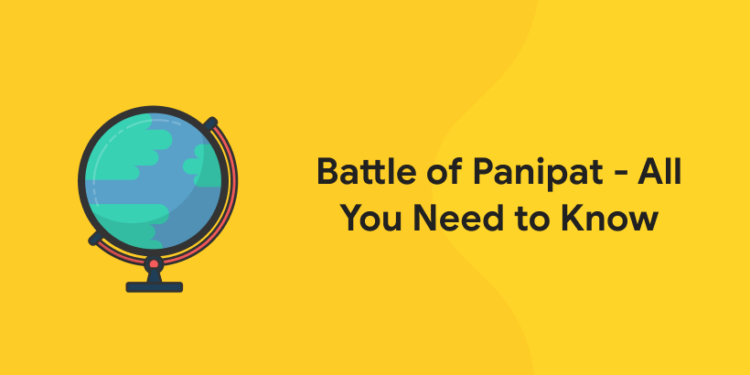Table of Contents
Panipat is the location of some of the most important battles that took place in the history of India. Panipat is a small village situated in the north of Delhi and is the location of three historic battles that wrought Mughal history. In total three Battles of Panipat took place namely First Battle of Panipat in 1526 fought between the Timurids under Babur and Ibrahim Lodi. Second Battle of Panipat in 1556, fought between the Hindu king Hemu and the Mughals under Akbar. Third Battle of Panipat in 1761, fought between the Maratha Empire and the Durrani Empire under the Afghan king Ahmad Shah Abdali.
This article gives you a glimpse of the depth knowledge of three important battle of Panipat. The Battle of Panipat is one of the most common and important questions asked from a historical perspective in competitive entrance exams like the UPSC, Railways, and SSC etc. So, let us take a look at some of the things related to these battles. So aspirants must carefully read the events and remember their respective dates to ace this section easily. Aspirants preparing for various competitive exams would found this article very helpful while their preparation.
| Battle of Panipat Overview | |||
| Name of Battle | Date | Fought Between | Place |
| First Battle of Panipat | 21 April 1526 | Timurids under Babur and Ibrahim Lodi. | Near Panipat |
| Second Battle of Panipat | 5 November 1556 | Hindu king Hemu and the Mughals under Akbar | Panipat |
| Third Battle of Panipat | 14 January 1761 | Maratha Empire and the Durrani Empire under the Afghan king Ahmad Shah Abdali.
|
Panipat |
Attempt free GK mock tests! Download Entri App!
First Battle of Panipat
When: 21 April 1526
Place: Near Panipat
Fought between: Babur and Ibrahim Lodhi
About the Battle
- The First Battle of Panipat was fought near a small village of Panipat in Haryana, this marked the beginning of the Mughal Empire in India.
- This battle saw the emergence of Mughal rule and gave a stronger foothold on the subcontinent. According to the legends, it was the earliest battles in which gunpowder firearms and field artillery were used.
- The battle was fought between the invading forces of Zahir-ud-din Babur and the last empire of the Delhi Sultanate, Lodi Empire during the rule of Ibrahim Lodi.
- This was a massive war that involved field artillery, musket guns, and gunpowder. It is said that Babur’s forces involved around 15,000 men and 20 to 24 pieces of field artillery. Whereas, Ibrahim Lodi’s forces involved 30,000 to 40,000 men along with 1000 war elephants.
- Ibrahim Lodi lost this war despite his huge army and war elephants. The reason behind this was the field artillery and guns used by Babur.
- Babur’s tactics had led him to win this war. He used the Tulughma and Araba Technique to fight against Lodi. Tulughma means dividing the whole army into three parts i.e. Left, Right and Center.
- The motive behind this was to attack the enemies from all sides as Babur had a small army and it was difficult to cover more ground and attack the huge forces of Lodi.
- The result of this war was that Ibrahim Lodi died on the field, abandoned by his own feudatories and generals. Hence, Babur took over the Delhi sultanate and this war paved the way for the Mughal Empire in Delhi.
Result
- The Mughal forces of Babur, the Timurid ruler of Kabulistan, defeated the much larger ruling army of Ibrahim Lodi, Sultan of Delhi.
- The victory enabled Babur to lay the foundations for the Indian Mughal Empire.
- Ibrahim Lodi died on the field of battle, abandoned by his feudatories and generals (many of whom were mercenaries).
- Most of them changed their allegiance to the new master of Delhi.
- However, the fate could have been turned in the favour of Sultan Ibrahim if he had survived another hour of fighting as Babur had no reserves left and his troops were rapidly tiring.
Second Battle of Panipat
1: Who was the first woman President of India?
When: 5 November, 1556
Place: Panipat
Fought between: Samrat Hem Chandra Vikramaditya, popularly called Hemu and Akbar
About the Battle
- It can be said that the Second Battle of Panipat marked the beginning of Akbar’s reign in India because it was the first year of Akbar holding the throne.
- The Second Battle of Panipat was fought between the forces of Samrat Hem Chandra Vikramaditya, popularly called Hemu, the Hindu king who was ruling North India from Delhi, and the army of Akbar, on November 5, 1556. It was a decisive victory for Akbar’s generals Khan Zaman I and Bairam Khan.
- The second battle of Panipat saw Hemu on one side who was leading his army himself with 1500 elephants and a vanguard of artillery. He marched forward with 30,000 skilled horsemen and afghans.
- On the opposite side, the Mughal army consisted of 10,000 cavalry, out of which 5000 veteran soldiers were highly experienced and were ready to beat Hemu’s advancing Army.
- Hemu was about to win the war until a turn of events took place. An arrow struck straight into Hemu’s squinting eye which passed his brain clean out from the cup of his head which led him to become unconscious.
- Hemu around the war area caused his army to disarray and be defeated in the ensuing confusion. After several hours, Hemu was found dead and his body was brought to Akbar’s tent in Panipat by Shah Quli Khan Mahram.
- The war resulted in the strong re-establishment of the Mughal empire in Delhi.
Result
- Hemu commanding his forces from atop an elephant was on a winning track and was about to rout Akbar’s army when an arrow struck Hemu’s squinting eye.
- The arrow passed his brain clean out from the cup of his head, and he became unconscious.
- Not seeing Hemu in his howdah (seat for riding on the back of a horse) , Hemu’s army was in disarray and defeated in the ensuing confusion.
- Several hours after the war ended, dead Hemu was located and captured by Shah Quli Khan Mahram and brought to Akbar’s tent in the camp in Panipat.
- Hemu’s supporters constructed a Cenotaph at the site of his beheading, which still exists at the village Saudhapur, on Jind Road at Panipat.
Attempt free GK mock tests! Download Entri App!
Free UPSKILLING Courses!
Take your first step toward mastering in-demand skills, acing interviews, and securing top-tier jobs with Entri's free upskilling courses.
Start Learning!Third Battle of Panipat
When: 14 January, 1761
Place: Panipat
Fought between: The Maratha Empire and a coalition of the King of Afghanistan, Ahmad Shah Durrani with two Indian Muslim allies namely the Rohilla Afghans of the Doab and Shuja-ud-Daula, the Nawab of Oudh.
About the Battle
- The Third Battle of Panipat took place at Panipat, about 60 miles (95.5 km) north of Delhi between a northern expeditionary force of the Maratha Empire and the King of Afghanistan, Ahmad Shah Durrani with two Indian Muslim allies— the Rohilla Afghans of the Doab, and Shuja-ud-Daula, the Nawab of Oudh.
- The battle has its importance as it ended the dominance of Marathas in India. At the time of the battle, Marathas were under the leadership of Peshwas and established control across Northern India and on the other side Afghans were under the leadership of Ahmed Shah Abdali.
- The Marathas finally fought the Mughals on 14 January 1761 with around 45,000 soldiers. Whereas on the other side, Abdala’s army consisted of around 60,000 soldiers.
- The Marathas managed to get an edge over the Mughals through the artillery provided by Ibrahim Gardi however they were badly defeated by the evening. Many Maratha rulers like Vishwas Rao, Jaswant Rao, Sindhia, etc. were killed in this war.
- The number of soldiers who died fighting in a single day was around 50,000-70,000 which is considered the biggest number in history.
Result
- The result of the battle was the halting of further Maratha advances in the north, and a destabilization of their territories, for roughly 10 years.
- This period of 10 years is marked by the rule of Peshwa Madhavrao, who is credited with the revival of Maratha domination following the defeat at Panipat.
- In 1771, 10 years after Panipat, Peshwa Madhavrao sent a large Maratha army into North India in an expedition that was meant to:
- Re-establish the Maratha domination in North India
- Punish refractory powers that had either sided with the Afghans, such as the Rohillas, or had shaken off Maratha domination after Panipat.
- The success of this campaign can be seen as the last saga of the long story of Panipat.
Conclusion
- The first battle was fought in the year 1526 between Babur and Ibrahim Lodi and paved the way for the Mughal Empire in India.
- The second battle was fought in the year 1556 which resulted in the re-establishment of the Mughal Empire under Akbar in Delhi.
- The third battle was fought in the year 1761 between the Maratha Empire and the invading Afghan Army.
Download Entri App, Entri provides you effective learnings in a period of time with the help of expert teams and you can accomplish the goal with the Entri App. Start your preparation for your dream government job with Entri App. We provide a wide range of courses over different government exams. We are providing you the best platform for the preparations for every prestigious exam. Here you can get access to a number of mock tests and get daily practice GK and Current affairs questions.













